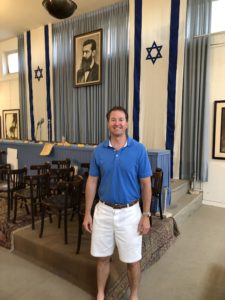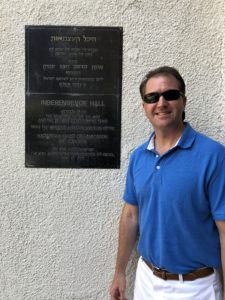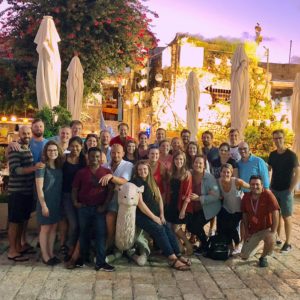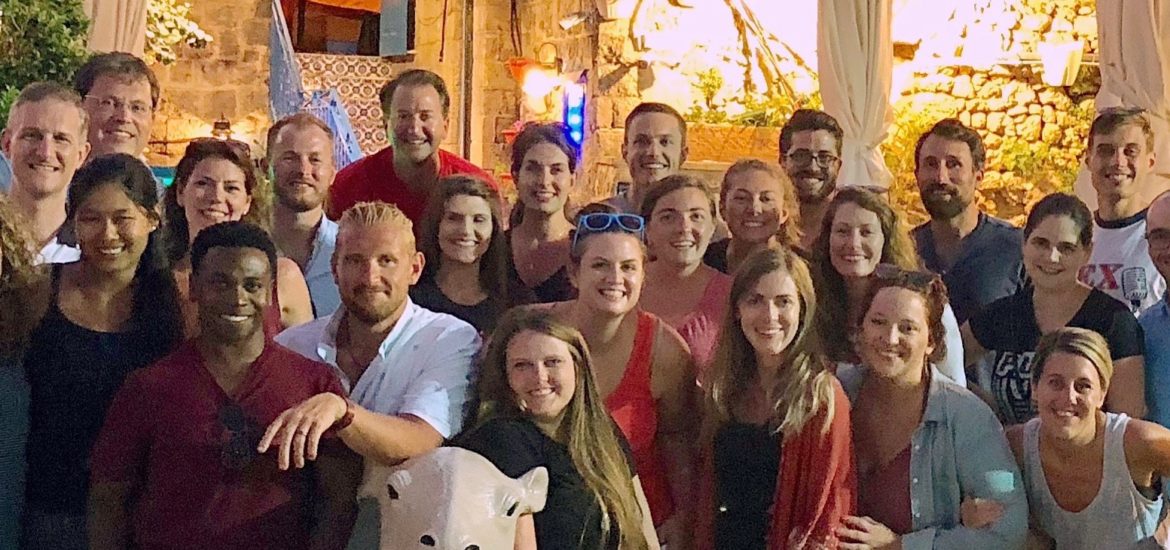On Monday, we awoke in Jerusalem for the final time of this trip. It was another early morning Israeli buffet breakfast in the hotel restaurant before we went downstairs to the conference room to hear a wonderful presentation by Miri Eisin, a former Colonel in the Israel Defense Force (IDF). She is also a Zionist. She was born in the United States, in California, before her family moved to Israel when she was a youth.
 She was drafted into the Israeli military after high school – like about 70% of Israelis are. She stayed in the military for several decades and became a deputy commander and has worked particularly in intelligence. She later became the international spokesperson for the Prime Minister of Israel, during their war with Lebanon, in 2006. Today, she teaches at a local college in Jerusalem and is married with three kids.
She was drafted into the Israeli military after high school – like about 70% of Israelis are. She stayed in the military for several decades and became a deputy commander and has worked particularly in intelligence. She later became the international spokesperson for the Prime Minister of Israel, during their war with Lebanon, in 2006. Today, she teaches at a local college in Jerusalem and is married with three kids.
Miri gave us a wonderful presentation that was very focused on the facts of the situation Israel is in. And she was extremely honest. She told us “no one is objective,” including her, when talking about the Israeli-Palestinian conflict. She also helped us understand how close Israel was to other places in the region. From the spot we were at in Jerusalem, we were a 20-minute drive to Jordan and a five-and-a-half-hour drive to Iraq. It takes me longer to drive across the state of Florida.
 Miri focused on six issues which she identified as the most important in this conflict: borders, sovereignty, settlements, security, refugees, and Jerusalem. She said if we are going to get beyond this conflict between Israel and the Palestinians, we have to resolve these six issues. She is also working under the assumption of a two-state solution. In addition, She said that any future border agreement should be “the compromise that both sides hate.” That’s almost the definition of compromise – being able to give up something you didn’t want to.
Miri focused on six issues which she identified as the most important in this conflict: borders, sovereignty, settlements, security, refugees, and Jerusalem. She said if we are going to get beyond this conflict between Israel and the Palestinians, we have to resolve these six issues. She is also working under the assumption of a two-state solution. In addition, She said that any future border agreement should be “the compromise that both sides hate.” That’s almost the definition of compromise – being able to give up something you didn’t want to.
It seems the biggest problem of the six issues she identified is that of Palestinian refugees – she had a map and statistics identifying who they are, where they were, and where she thought they should go or be settled. She told us that the solution to fix this conflict is clear, but not simple. I really liked Miri and was grateful we were fortunate to hear from her.
 After her presentation, we checked out of the hotel and boarded our bus. Our last stop in Jerusalem was to the Garden Tomb. This is a very controversial site and after our visit there, I rate it as complete bogus – in terms of its historical veracity. And I’ve since done more reading on this site and discovered the truth about it. Back in the late 19th century, there were a lot of Christians who began visiting the Holy Land from the United States. And most of them were from a variety of Protestant denominations – and many of these Christians were not even from mainline Protestant denominations.
After her presentation, we checked out of the hotel and boarded our bus. Our last stop in Jerusalem was to the Garden Tomb. This is a very controversial site and after our visit there, I rate it as complete bogus – in terms of its historical veracity. And I’ve since done more reading on this site and discovered the truth about it. Back in the late 19th century, there were a lot of Christians who began visiting the Holy Land from the United States. And most of them were from a variety of Protestant denominations – and many of these Christians were not even from mainline Protestant denominations.
The traditional site identified as the crucifixion and tomb of Christ is at the Church of the Holy Sepulchre. After much research and investigation, this site was identified by Helena, the mother of the Roman emperor, Constantine, during her visit to the Holy Land between 326-328 AD. And, most scholars and archeologists throughout the ages including today agree with Helena that where the Church of the Holy Sepulchre now is likely was the area Jesus was crucified and put in a tomb. However, we don’t know for 100% certain where Jesus was crucified and where his tomb was. National Geographic has run a special on this in the past year. As Christians, of course, we believe that no matter where the tomb was, his body is no longer there. For he rose from the dead and ascended into heaven.
 What we do know is that the earliest Christians identified the site where the Church of the Holy Sepulchre – and since that time that site has been run by the Roman Catholics, Greek Orthodox, Armenians, and Coptic Christians. So, it seems through my reading that some of these Protestants who came to Jerusalem in the late 19th century, amid all the conflict going on there, wanted their own site – and they found a site in the late 19th century where there is a rock that looks like a Skull. And, you know, in the Bible it says Jesus was crucified at Golgotha, which translates to “place of the skull.”
What we do know is that the earliest Christians identified the site where the Church of the Holy Sepulchre – and since that time that site has been run by the Roman Catholics, Greek Orthodox, Armenians, and Coptic Christians. So, it seems through my reading that some of these Protestants who came to Jerusalem in the late 19th century, amid all the conflict going on there, wanted their own site – and they found a site in the late 19th century where there is a rock that looks like a Skull. And, you know, in the Bible it says Jesus was crucified at Golgotha, which translates to “place of the skull.”
Here’s the thing: we don’t even know if that is what it looked like 2,000 years ago. In fact, the tour guide at the Garden Tomb who showed us pictures of what the place looked like when it was discovered just over a hundred years ago, showed us how it looked different then from what it does today. Our guide also didn’t express a lot of confidence that this was “the” site.
 What is true is that there are some tombs in the area of this “Garden Tomb” site, many which dates to even before the time of Christ. We visited what some there believe is the possible tomb of Christ. It certainly looks like the kind of place you envision Jesus being buried at. And so, for that reason, and that reason alone, it is a nice place to visit: to get a sense of what Jesus’ tomb looked like before Christians put a mighty church around it.
What is true is that there are some tombs in the area of this “Garden Tomb” site, many which dates to even before the time of Christ. We visited what some there believe is the possible tomb of Christ. It certainly looks like the kind of place you envision Jesus being buried at. And so, for that reason, and that reason alone, it is a nice place to visit: to get a sense of what Jesus’ tomb looked like before Christians put a mighty church around it.
As a group, we had a prayer and partook in a Protestant-style communion service (after all, the Israel Collective is mostly a Protestant group). As we were wrapping up our final hours in Jerusalem, it was also very nice come together in communion with all the members of our group during this service, led by Deamon Scapin, the minister who traveled with our group. He delivered another great short sermon for us to bring us together in our concluding spiritual gathering in Jerusalem.
Before we left the Garden Tomb, we visited a nice little gift shop there for we American tourists and I picked up some things, including a cool map of Israel and a Bible timeline. We then hopped on the bus and traveled towards Tel Aviv. But first we stopped for lunch at an amazing neighborhood restaurant called Nagi in a very friendly Arab village named Abu Ghosh. The food here is something I really knew I was going to miss. And we even saw a sign in the place where CNN had named it the third best kabob joint in the world.
 Tel Aviv is about a two-hour drive from Jerusalem, but it is almost a world away. While Jerusalem is an ancient city, Tel Aviv is modern. It is also situated right on the Mediterranean, with beautiful beaches and hundreds of tall buildings, with new ones being constructed at the moment. It really reminded me of Miami with how bustling it is and with the beach right there. Except in addition to all that Miami has going on, Tel Aviv has become a hub for many start-up tech companies. Merge Silicon Valley and Miami and you have Tel Aviv. It’s also quite liberal compared to the very orthodox Jerusalem.
Tel Aviv is about a two-hour drive from Jerusalem, but it is almost a world away. While Jerusalem is an ancient city, Tel Aviv is modern. It is also situated right on the Mediterranean, with beautiful beaches and hundreds of tall buildings, with new ones being constructed at the moment. It really reminded me of Miami with how bustling it is and with the beach right there. Except in addition to all that Miami has going on, Tel Aviv has become a hub for many start-up tech companies. Merge Silicon Valley and Miami and you have Tel Aviv. It’s also quite liberal compared to the very orthodox Jerusalem.
Our first stop was to Israel’s Independence Hall, the site of Israel’s Declaration of Independence. It was from this spot in 1948, that David Ben-Gurion proclaimed the State of Israel, through a televised radio address. Their declaration was made in conjunction with the last British soldiers leaving the region of Palestine after decades of occupation. While the Brits weren’t officially leaving until May 15, the announcement was made at 4:00 PM on Friday, May 14, just a couple hours before the Jewish Sabbath would begin. The room looked almost identical to the way it looked when we walked in it 70 years later, in 2018. I really felt like we had walked through history this week – from the Sea of Galilee, into Jerusalem, and now into the modern State of Israel.
 While U.S. President Harry Truman immediately recognized the State of Israel (there was some controversy about him doing this as President), the response in the Arab world was one of war. The nations of Egypt, Transjordan, Iraq, and Syria all attacked Israel within days. This became known as the 1948 Arab-Israeli war and fighting went on for a little over a year. Israel won the war and secured their independence. However, as we know, the past 70 years has been one of constant conflict for Israel in defending itself, mostly from the Arab world and that independent body known as the United Nations. It has very few allies, but it has a great friend in the United States.
While U.S. President Harry Truman immediately recognized the State of Israel (there was some controversy about him doing this as President), the response in the Arab world was one of war. The nations of Egypt, Transjordan, Iraq, and Syria all attacked Israel within days. This became known as the 1948 Arab-Israeli war and fighting went on for a little over a year. Israel won the war and secured their independence. However, as we know, the past 70 years has been one of constant conflict for Israel in defending itself, mostly from the Arab world and that independent body known as the United Nations. It has very few allies, but it has a great friend in the United States.
After seeing this historic spot, we made our way to our hotel. We stayed at the Carlton, a very modern hotel right on the beach. It was about a 20-story building that had a rooftop pool and many of us spent the rest of the afternoon there. A few of us also ventured down to the beach and enjoyed some surf and sand (and my traditional vacation ice cream cone). We then had a wonderful dinner in Tel Aviv and then we split off into smaller groups to do a little minor bar hopping. I called it a night near midnight, but some of the other members of the group stayed out later.
 The next day we awoke to the most wonderful breakfast spread these eyes may have ever seen. It was part of the Carlton hotel’s package and it was tremendous. This was our last morning in Israel and they were sending us out with our bellies full of delight. Following breakfast, we did a boat ride organized for us by the Israel Collective. We were out on the boat for a couple hours just enjoying the Mediterranean and the Israeli coastline. In the afternoon, we all split off and did our own thing. Some went shopping, but I decided to relax a bit on the beach with a few other members of our crew.
The next day we awoke to the most wonderful breakfast spread these eyes may have ever seen. It was part of the Carlton hotel’s package and it was tremendous. This was our last morning in Israel and they were sending us out with our bellies full of delight. Following breakfast, we did a boat ride organized for us by the Israel Collective. We were out on the boat for a couple hours just enjoying the Mediterranean and the Israeli coastline. In the afternoon, we all split off and did our own thing. Some went shopping, but I decided to relax a bit on the beach with a few other members of our crew.
We had a late flight out of Tel Aviv that night, so this allowed us another full day in Tel Aviv. Our hotel arrangements also allowed a late check out. So, I took a nice shower, packed my bags, and met the group downstairs around 5:00 PM. Our bus took us just a few miles down the road to a smaller suburb of Tel Aviv, but a historic city in and of itself, Jaffa. This city is famous for many Biblical stories including that of Jonah and the whale. St. Peter also spent some time there and there was a church we walked by named in his honor. Jaffa is on the coast and over the centuries, many armies and prophets came in through Jaffa on their way to Jerusalem.
 The Israel Collective did not disappoint at all during any of this trip, especially when it came to the food selections. We were served a monstrous meal, once again served family style with many appetizers and entrees. It was a beautiful evening in an outdoor courtyard area and it was just a perfect ending to our time of fellowship over these past 9 days together. We reminisced about many of our favorite moments throughout this beautiful and historic country. Before we left, we all took a really nice group photo together which is pictured here in this post. These are the fellow pilgrims that journeyed together through the land of the Bible.
The Israel Collective did not disappoint at all during any of this trip, especially when it came to the food selections. We were served a monstrous meal, once again served family style with many appetizers and entrees. It was a beautiful evening in an outdoor courtyard area and it was just a perfect ending to our time of fellowship over these past 9 days together. We reminisced about many of our favorite moments throughout this beautiful and historic country. Before we left, we all took a really nice group photo together which is pictured here in this post. These are the fellow pilgrims that journeyed together through the land of the Bible.
I will never forget these people, this experience, the wonders of Israel, the spiritual growth, and the personal friendships we made with many Jews, Christians, and Muslims we met along the way. But I owe a huge debt of gratitude to my friend Ryan Nichols who nominated me for this trip and to the Israel Collective for inviting me and for showing us all the trip of a lifetime. I plan to journey back here again in the future, hopefully many times, as there is so much more to experience. But my lifelong dream of visiting Israel not only came true, but the trip itself was nothing short of perfection. I left here amazed, inspired, and fulfilled.

Thanks for sharing! So thankful that you had this opportunity!